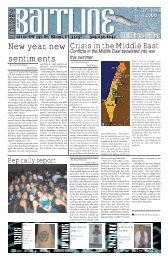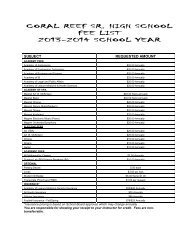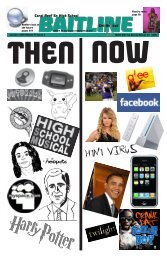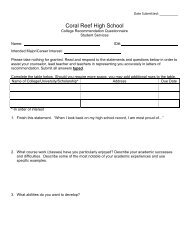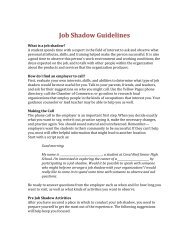Code of Student Conduct - Coral Reef Senior High School - Miami ...
Code of Student Conduct - Coral Reef Senior High School - Miami ...
Code of Student Conduct - Coral Reef Senior High School - Miami ...
You also want an ePaper? Increase the reach of your titles
YUMPU automatically turns print PDFs into web optimized ePapers that Google loves.
<strong>Code</strong> <strong>of</strong> <strong>Student</strong> <strong>Conduct</strong> – Secondary<br />
Best Practices and Suggestions for<br />
Rewarding Model <strong>Student</strong> Behavior<br />
The District believes in the dignity, worth, and potential <strong>of</strong> each and every student, and<br />
provides opportunities to enable all students to make the dream <strong>of</strong> education a reality. In<br />
fulfillment <strong>of</strong> these ideals, the vision <strong>of</strong> the Superintendent <strong>of</strong> <strong>School</strong>s is to encourage and<br />
recognize positive model student behavior, which means, our purpose is to reward and<br />
recognize students for striving to do their best, and for giving respect to fellow students and<br />
teachers.<br />
Studies have revealed that model student behavior improves when students<br />
• know what is expected <strong>of</strong> them at school;<br />
• believe they have the academic and social skills to achieve;<br />
• are recognized and given praise for doing good work or behaving appropriately;<br />
• feel that there is someone at school who seems to care about them as people; and<br />
• believe there is someone at school who encourages their development.<br />
Studies also indicate the importance <strong>of</strong> parental support<br />
• <strong>Student</strong> achievement related to parent support is not limited to the early years, but is<br />
significant at all ages and grade levels.<br />
• Children <strong>of</strong> involved parents achieve more regardless <strong>of</strong> socioeconomic status,<br />
ethnic/racial background, or the parents’ educational level.<br />
• Children <strong>of</strong> involved parents exhibit more positive attitudes and behavior.<br />
• Children <strong>of</strong> involved parents have fewer instances <strong>of</strong> alcohol use, violence, and<br />
antisocial behavior.<br />
• Children <strong>of</strong> involved parents have higher grades, test scores and better attendance, and<br />
are more likely to graduate from high school and have greater enrollment in postsecondary<br />
education.<br />
Research <strong>of</strong>fers some suggestions for schools to clearly communicate expectations for model<br />
student behavior<br />
• The school must provide a well-written set <strong>of</strong> model student behavior expectations for the<br />
school.<br />
• The set <strong>of</strong> expectations is short (generally from 5 to 7 items).<br />
• <strong>Student</strong>s should be involved in the development, refinement, and communication <strong>of</strong> the<br />
expectations <strong>of</strong> model student behavior.<br />
• The model student behavior expectations are statements <strong>of</strong> how to achieve model<br />
behavior, rather than what not to do.<br />
• Model student behavior expectations are posted prominently throughout the school.<br />
• Model student behavior expectations are emphasized in each classroom (e.g. explicitly<br />
taught, reminded, and encouraged).<br />
• <strong>Student</strong>s should be encouraged to remember and repeat statements <strong>of</strong> model student behavior.<br />
Adapted from G. Roy Mayer (2000) California State University, Los Angeles<br />
63





